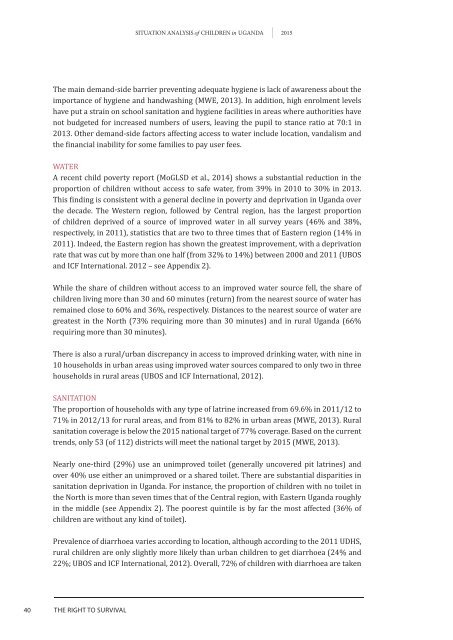Situation analySiS
1TNu802
1TNu802
You also want an ePaper? Increase the reach of your titles
YUMPU automatically turns print PDFs into web optimized ePapers that Google loves.
<strong>Situation</strong> <strong>analySiS</strong> of Children in uganda 2015The main demand-side barrier preventing adequate hygiene is lack of awareness about theimportance of hygiene and handwashing (MWE, 2013). In addition, high enrolment levelshave put a strain on school sanitation and hygiene facilities in areas where authorities havenot budgeted for increased numbers of users, leaving the pupil to stance ratio at 70:1 in2013. Other demand-side factors affecting access to water include location, vandalism andthe financial inability for some families to pay user fees.WATERA recent child poverty report (MoGLSD et al., 2014) shows a substantial reduction in theproportion of children without access to safe water, from 39% in 2010 to 30% in 2013.This finding is consistent with a general decline in poverty and deprivation in Uganda overthe decade. The Western region, followed by Central region, has the largest proportionof children deprived of a source of improved water in all survey years (46% and 38%,respectively, in 2011), statistics that are two to three times that of Eastern region (14% in2011). Indeed, the Eastern region has shown the greatest improvement, with a deprivationrate that was cut by more than one half (from 32% to 14%) between 2000 and 2011 (UBOSand ICF International. 2012 – see Appendix 2).While the share of children without access to an improved water source fell, the share ofchildren living more than 30 and 60 minutes (return) from the nearest source of water hasremained close to 60% and 36%, respectively. Distances to the nearest source of water aregreatest in the North (73% requiring more than 30 minutes) and in rural Uganda (66%requiring more than 30 minutes).There is also a rural/urban discrepancy in access to improved drinking water, with nine in10 households in urban areas using improved water sources compared to only two in threehouseholds in rural areas (UBOS and ICF International, 2012).SANITATIONThe proportion of households with any type of latrine increased from 69.6% in 2011/12 to71% in 2012/13 for rural areas, and from 81% to 82% in urban areas (MWE, 2013). Ruralsanitation coverage is below the 2015 national target of 77% coverage. Based on the currenttrends, only 53 (of 112) districts will meet the national target by 2015 (MWE, 2013).Nearly one-third (29%) use an unimproved toilet (generally uncovered pit latrines) andover 40% use either an unimproved or a shared toilet. There are substantial disparities insanitation deprivation in Uganda. For instance, the proportion of children with no toilet inthe North is more than seven times that of the Central region, with Eastern Uganda roughlyin the middle (see Appendix 2). The poorest quintile is by far the most affected (36% ofchildren are without any kind of toilet).Prevalence of diarrhoea varies according to location, although according to the 2011 UDHS,rural children are only slightly more likely than urban children to get diarrhoea (24% and22%; UBOS and ICF International, 2012). Overall, 72% of children with diarrhoea are taken40 thE rIGht to SUrvIvaL




